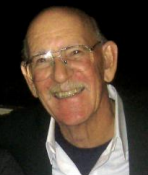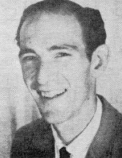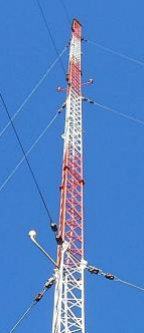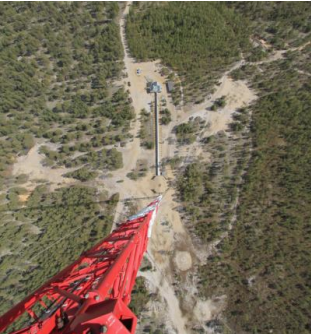My First View From The Very Top

[April 2015] In the days before liability and insurance issues, many engineers also changed out their own light bulbs – yes, including the ones at the top of the towers. How would you react the first time you were told to do it? Ted Thayer reaches back exactly 50 years to recall his first time and how it affected him.
Relatively few engineers have the opportunity to visit the very top of their towers. But those who do are rewarded with a view like nothing else.
A California DJ and More
I started working as a disc jockey at KDON, a 5000 Watt “Good Music” station licensed to Salinas, California in September 1964.
KDON was situated on the shore of California’s picturesque Monterey Bay. Purposely directional, the station beamed its signal over three major bay area cities: Monterey, noted for Steinbeck’s description of that city in “Cannery Row,” the county seat, Salinas, several miles inland and famous for its produce, and Santa Cruz, known around the world for its excellent surf and friendly vacation atmosphere.
While I got the job there as a disc-jockey, I was also the one who was interested in the technical end of the station. So, after six months of tinkering with station equipment, early in 1965, I was appointed Chief Engineer for the station.
The Newly Minted CE
Then, as now, the CE job was interesting – for the “Chief” had many duties.
He must keep all equipment in good running order with a program of regular cleaning, maintenance, and checking to prevent major break- 2 downs. He must run special tests periodically to prove that the quality and quantity of the signal does not decay. He must be well-versed in trouble-shooting and repair of electronic circuits and must keep up to date on electronic developments.
In fact he must, of necessity, be a lot more: mechanic, carpenter, TV Repairman, bookkeeper, plumber, electrician, artist, humorist, writer, landscaper, and janitor, among assorted other duties. And, he must be available for work 24 hours a day, seven days a week since he is also was responsible for keeping the station on-theair regardless of the hour.
The FCC Comes Visiting
Late in April 1965, the Federal Communications Commission sent its inspector to the station for the what was then an annual check-up.
The annual check-up was a brief inspection verifying that FCC Commission’s Rules and Regulations were strictly followed broadcasters. The station fared pretty well, all things considered – though there were several minor infractions that could be remedied easily.
One of the “gigs,” as FCC citations were often called, was for “failing to have all the tower obstruction lights burning.” The antenna system had two towers, each having six lights, two at each of three levels. However, we had only six of the twelve lights burning.
The bottom line: somebody had to climb the towers and change the bad bulbs. You can probably guess pretty easily who had to do it!

Some Modestly Tall Towers
 KDON’s towers stood 198 feet above the base insulators, four feet off the ground. Each tower, then, was 202 feet, six inches high. And I had to conquer every inch on both towers.
KDON’s towers stood 198 feet above the base insulators, four feet off the ground. Each tower, then, was 202 feet, six inches high. And I had to conquer every inch on both towers.
Typical for uniform cross-section towers, they were held erect by a series of guy wires attached at three levels, three per level, except at the top, where there were three extra wires attached to make the radio signal more efficient. The structures were a lattice-work of steel, like that on many bridges. There were no ladders since the cross-member were at “climbable intervals.”
So it was that at 10:15AM on April 28, I began an adventure I will never forget.
Ready to Go
Decked out in my old Marine Corps boots, Levis, sweatshirt, and nylon windbreaker, I set out to scale the southwest tower in order to replace three light bulbs – two at the first level and one at the top.
I latched on my safety belt and checked to see that I had everything: three 118-Watt traffic globes, a pair of pliers, hammer, large screwdriver, and a roll of electrical tape.
The deejay on duty announced the station would be off-the-air for just a minute while I climbed onto the tower. I stepped on a large wooden box next to the tower and signaled the deejay to turn the station back on. Since I was not touching the ground, there was no danger of lethal electrical shock.
Or so I thought.
The Ascent Begins With a Lesson
There I was, seven or eight feet off the ground on a “hot” tower, contemplating what seemed from my vantage point a climb akin to Mount Everest, when I discovered that my gloves were missing.
I put my safety belt around the tower and hollered for the gloves, letting go of the structure and leaning back on the belt. After the gloves were thrown up to me, I put them in my coat pocket and reached for the tower.
Zzzap! A three-inch spark reached out and grabbed my hand with a cooking jolt of radio current!
Recoiling, I found a quarter-inch burn on my right index finger. Ouch! Having completely forgotten that my boots had composition soles, I had let go of the tower and was no longer part of it. The boots and safety-belt acted as insulation so the space between me and the tower acted like a battery. When I reached for the tower I complete a short circuit, and … bang!
Rather annoyed, I cursed, threw the gloves down, and grabbed the metal structure with both hands, gritting my teeth as the sparks hit. “Keep a hand on that tower or wrap a leg around it at all times,” I reminded myself.
Working My Way Up
Now fully alert to the voltages flowing in the tower, I carefully undid the safety-belt and placing the hook on the end of it over the crossmember above me and started up.
One foot up, one hand up, the other hand up, the other foot up – three feet at a time. Over and over, again and again.
Periodically, I stopped for a breath. It is hard enough walking up a long hill, but climbing straight up is murder. As I looked down, I muttered “Jeeze” to myself. The 50 feet or so to the dirt already looked more like a mile! And I was more than aware of a knot growing in the pit of my stomach.
Looking out a third or fourth-story window is exciting, but hanging onto a cold hunk of steel at that height is paralyzing. In a building you have a whole room under your feet – but on a radio tower, you have nothing but a piece of steel a quarter of an inch wide and maybe a foot and a half long for support. One slip and …..
Second Thoughts
I started to shake with terror. Stomach-tightening, throat-drying fear! Oh, how I wished I had never seen a radio tower.
Everything seemed suddenly exaggerated. The wind was colder, the sun brighter. I could smell the oxidized paint on the tower and my mouth tasted wooly. The burn on my finger throbbed and my knees ached from strain of the climb.
Looking up, it did not seem too far to the first set of lights. It seemed stupid to quit without even getting half-way, so I started climbing again, very carefully, making sure each foot and hand-hold was secure.
And as I pressed upward, I prayed.
Halfway to the Top
Once I reached the first set of lights, I strapped myself securely to the tower.
The first bulb went in easily, but I almost dropped the red glass cover from the second one. My hands were so cold from the steel of the tower I almost dropped the pliers, too. The thought of having to climb all the way down and back for a lousy pair of pliers was not a pleasant one.
Finishing up at the first level, I it was time to resume my climbing. There had been a breeze when I mounted the tower, but by the time I reached the two-thirds level, it seemed like a 4 gale. Its bite was icy-cold and made my ears ache. I rested often, thighs smarting from the push-push of difficult, straight up, muscle-straining ascent.
Finally reaching the top, I found the six guy wires came together in a spider web of metal, topped with a pair of red glass protuberances. To get to these obstruction lights, I had to work my way through the maze and finally perch on the steel plate that joins it all together at the top.
I had made it to the top all right, but not without a considerable amount of reflection about Newton and his apples.
Top of the World!
Amazingly, once I was securely seated on the top, the fear of the climb completely left me.
The view from two-hundred feet plus is simply magnificent. Exhilarating.
Twenty miles to the south-west lay the Monterey Peninsula. I could see the Jack Pines and Cypresses outlined on the skyline as if they were only a hundred yard away.
Out behind the big Pacific Gas and Electric plant at Moss Landing to the south Salinas was visible.
To the east was Watsonville, sprawling across the lush Pajaro Valley at the foot of the Coast Range. And north, up the coast, I could see the beach communities of La Selva, Seacliff, Soquel and Santa Cruz as well as a stretch of killer Highway 17 in the mountains east of Santa Cruz.
A Real Birds’ Eye View
It was a whole new way of looking at my surroundings.
Several sailboats were out in the bay, the stiff breeze pushing them along through the whitecaps like little sticks of wood with cocked-hat sails. A airplane, a new Piper, flew down the beach about a hundred feet above the ground – yet still well below my small but comfortable perch.
I had the bulb replaced at the top in no time and sat for a while, resting, satisfied with what I had personally achieved, and just plain enjoying the view. The sun was warm and the wind seemed calmer.
Indeed, I felt secure and happy until I decided it was time to start down.
Time to Head Back Down
Imagine, if you will, a stool as high as a giant redwood and imagine a baby climbing off that chair.
Now, imagine that you are the baby perched on that giant stool!
Maybe this helps you visualize my terror as I sat there staring down the tower.
Getting through the formidable spider-web of wire without falling was a panic all by itself – and by the time I had secured myself again to the side of the tower, my mind was filled with misgivings about my ability to make it down safely.

My heart fluttered, my hands quivered, and I could not control the trembling in my legs. My knees shook as well. I was sure they could not support my weight.
I must have clung to the structure of five minutes before getting up enough courage to try a few steps down.
The descent was best described as painful, and when I reached the ground I was completely exhausted. But, there was another set of bulbs to change, so the next day I scaled the northeast tower, although now I knew much better what to expect.
I have scaled a number of towers since that time, but I never surpassed the exhilaration and excitement experienced on my first trip up the southwest tower at KDON in the spring of 1965.
– – –
Ted Thayer was a broadcast engineer and disc jockey before a career change led him to Globe, AZ. Now retired, Ted stays busy with his wife and journalistic interests, including hosting and webmastering a number of websites. You can contact Ted at tedthayer@cableone.net
